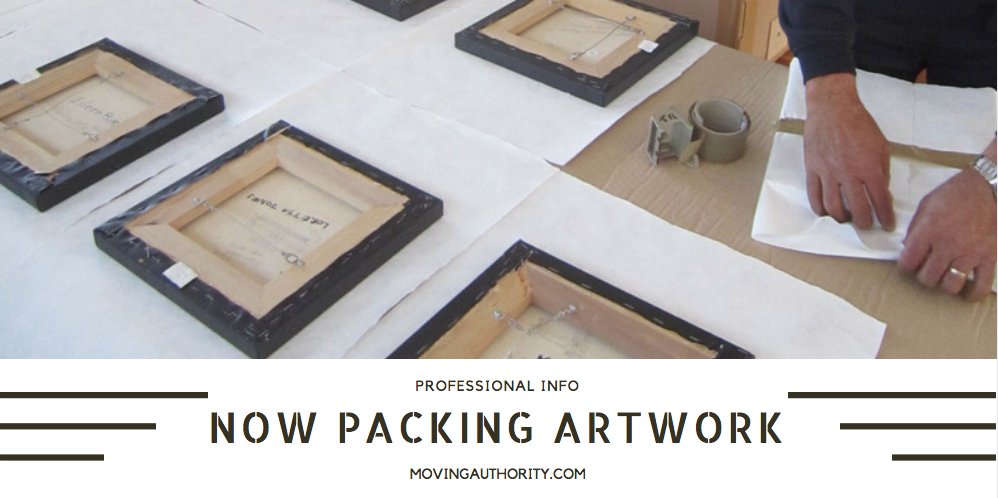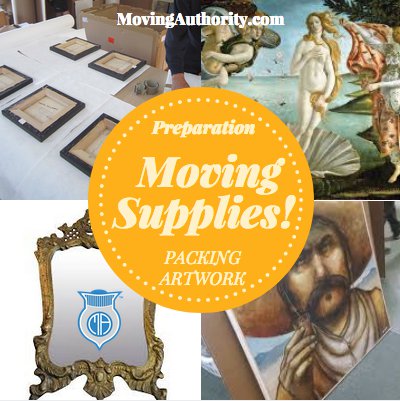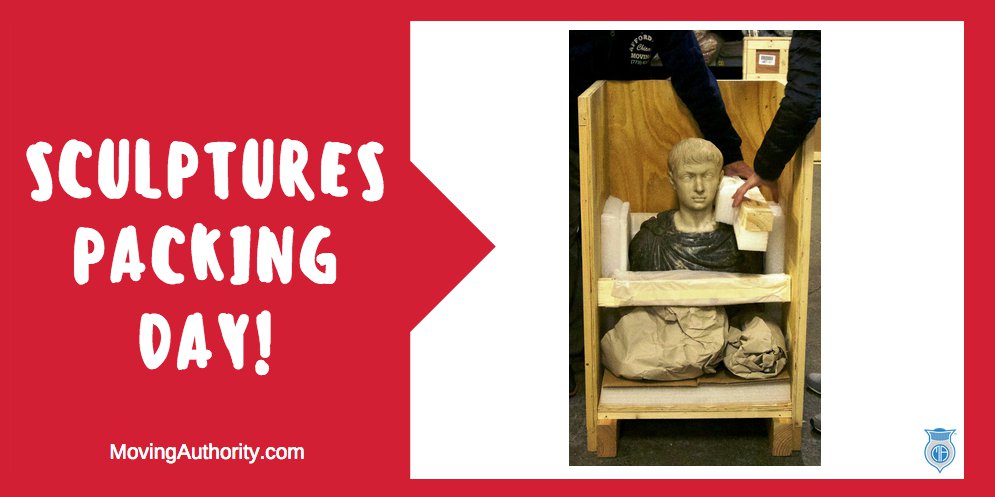A Complete Guide to Packing Artwork - Packing Is Crucial For Damage Prevention

Guide to Packing Artwork - Packing Is Crucial For Damage Prevention
- Packing is Already Hard & Now Packing Artwork?
- Establish Inventory - DIY Packing Artwork or Professionally?
- Suggested Preparation and Moving Supplies
- Packing UnFramed Artwork Systematically
- How to Pack Framed Artwork or Paintings
- Canvas Paintings Are Easily Damaged - Pack Properly!
- Mirrors - Easier Than They Look
- Sculptures
- Labeling - A Fundamental In Fragile Packing
- Wooden Crating Options
- Professional Art Moving Companies
- Moving Authority is a Resource for Your Packing Artwork Needs
1. Packing is Already Hard & Now Packing Artwork?
If you need to go about packing artwork or something related to this type of packaging, this guide will inform you on how to properly go about packing artwork. Packing, in general, is quite a hard task, to begin with. Depending on your type of move, the quality of your packing usually varies. For example, athletes have to keep track of specific items as well so they need to properly pack to prepare for their move. Professional packing services are usually available by many moving companies, however, they typically will not want to pack your high-valued fragile items.
If you arrange a plan before packing artwork, antiques, mirrors, and delicates etc. you'll be able to get your high-value goods or keepsakes packed properly. Artwork, whether they are unframed, oil, acrylic, pastel, watercolor, glass, etc., can be quite invaluable to people emotionally and valuable financially as well. It is also good to be aware of what goods moving companies won't move for you either, such as sentimental goods. With this guide, packaging paintings should be a cinch.
2. Establish Inventory - DIY Packing Artwork or Professionally?
Although inventory is a rather meticulous task, it is an unfortunate first step in the process to packing artwork correctly. It is significant to do this because it allows you to go through and evaluate your specialty items. Take this time to discern which items you can pack yourself and which of your items must be handled by professionals in packing artwork such as items that are extremely heavy, for example, a mirror, or anything that is of extreme value.
Weight can influence if it can be packing in a durable box or if wooden crating is necessary to pack it securely. During this phase, if possible, you may want to get any high-valued artwork appraised. By the law of the USDOT, if you are packaging art for shipping that is valued at or over $5,000 dollars you must ship the item by a custom wooden crate. This is optional for items under the value of $5,000, but it is something to consider in the unfortunate and unforeseen event something is damaged.
Ask your movers about valuation and insurance to understand the differences. Also, ask them to explain both types of valuation - released value protection full value protection. It is best to be aware of any surprises that may follow in the future of your move. Also, allow time for deciphering sizes, quantity, and type as well.

3. Suggested Preparation and Moving Supplies
In order to properly package your artwork, you will need the correct materials and supplies to prevent possible damage. Depending on the what artwork, packing supplies can range from cardboard, tissue paper, bubble wrap, blanks, furniture pads, packaging tape, painters tape, and packing paper. Plastic wrap is also a widely used resource by moving companies unbeknownst to many consumers.
For large paintings or any mirrors, be sure to have specially made picture boxes you can get at the store. Although similar to regular cardboard boxes, these should be large and flat - the perfect shape for protecting and packing artwork. You may want to consider corner protectors as an added supply to your list to further avoid damage to your artwork or damage to other goods in your shipment. A sculpture is something that requires unprinted packing paper, along with bubble wrap and styrofoam peanuts. With the right supplies and guidance, this should be an easy DIY packing project.

4. Packing UnFramed Artwork Systematically
It is crucial for the protection of your artwork that you have the appropriate boxes and equipment designed for packing and moving artwork. You can find these at many stores that are considered 'specialty boxes' specifically for these types of moving needs.
- Begin by lining the specialty box by putting the packing paper at the bottom of the box crumpling it up or by putting styrofoam peanuts at the bottom to create a cushioning effect. Do not close the top of the box.
- Take each individual piece of artwork, if you've purchased corner protectors, and put it cushion on each corner. Then take the packing paper and wrap the artwork with it and, for extra security, you may choose to wrap it with bubble wrap as well.
- Carefully place your artwork in the specialized box for packing artwork and fill any and all empty space with extra packing paper and/or peanuts for extra protection. If you are packaging multiple pieces of artwork or pictures with glass frames, follow the same procedure to avoid damaging of the glass, in particular.
- Tape the bottom of the box well so this way you can slide your artwork carefully into the box with the opened end of the box in an upright position.
- Once you have slid the artwork into the box, you will need to secure it with packaging tape, this is highly important so don't be afraid to use a little extra tape.
With your artwork packed now, you will want to make sure that it is not set down flat but kept upright to allow the edge of the artwork to absorb any pressure, rather than the face of your valued artwork.
5. How to Pack Framed Artwork or Paintings
Many of the steps of packing artwork that is framed are similar to being unframed, however, when packing framed artwork there are a few extra steps to take. Begin by taking painters or masking tape and put it across the front of the painting like an 'X'. This is to keep all pieces together in case there is a crack or the glass breaks in any way. Next, cover the framed painting or artwork with bubble tape. Ensure that it is clearly covered all the way around the item.
Similar to unframed artwork, you will want to use a specialty box and add padding in the form of packing paper or peanuts before slipping the framed artwork into the box. Fill any looseness in the box by continuing to put wadded paper in until the artwork is secure in the box. If you find that you cannot get a specialty box large enough, take a second specialty box and put it on top of the other. Make sure they fit together and no extra space is left.
6. Canvas Paintings Are Easily Damaged - Pack Properly!
For canvas painting, the packing artwork procedure is similar, however, you DO NOT want to employ the use of bubble wrap. This is due to bubble wrap's oil base, which has great potential to and will ruin canvas. Instead, you will need to use glass nine wrapping paper, which is an oil free packaging paper. To protect it even further, put it into another, larger box. This will prevent sharp objects or corners from damaging or poking holes in your precious canvas.
Fill the larger box with glass nine oil free packing paper to ensure that your precious canvas will be dent or hole free. Finally, you will want to label the box as fragile art or however you like to label it. Be sure to ensure that you write fragile on every piece of artwork or valuable item that you decide on packing yourself. Specifically be sure to write fragile on the sides of artwork!
7. Mirrors - Easier Than They Look
Packing mirrors are fortunately similar to packing artwork that is framed and involves glass. Just like with framed artwork, start by using painting or packing tape in a shape of an X so if it is possibly cracked, the pieces will stay together without flying out everywhere. Using the same specialty boxes wad up packing paper and cushion the bottom. After wrapping the mirror in packing paper or bubble wrap (or both), slide the mirror into the box. If the box isn't big enough, use the same approach used in packing artwork that is framed. DO not use a single walled box, must use a double walled box to protect the delicacy of the mirror.

8. Sculptures
When thinking about talking how to safely package sculptures, regardless of size or style, it can be rather intimidating. Not to worry, the process of packing artwork such as this is not as difficult as one might think. Start with a box that is a larger size that the sculpture you are packing is. Again, fill the bottom of the box with a large amount of wadding packing paper and/or styrofoam peanuts until it is about a third full. Remember, if the item is valued over 5,000 you must invest in a custom wooden crate.
Using bubble wrap, wrap the item with plenty of bubble wrap and secure it with tape. Once you have prepared the packaged artwork, it is ready to be boxed, be sure to keep it in an upright position. Of course, fill the entire free space left with styrofoam peanuts and/or wadded packing paper until it is secure. Tape the box well and be sure to check the security of the box.
9. Labeling - A Fundamental In Fragile Packaging
When moving household goods such as artwork, delicate or valuable items, or delicate sentimental item, the process and way in which they are packed is a priority throughout the moving process. Being appropriately prepared is fundamental to protecting your artwork or other delicate items. Labeling is yet another substantial and core element to preventing accidents. It is cardinal to determine a labeling system during a move, especially with fragile pieces of artwork, glass, etc.
Everytime you finishing packing artwork or other delicates, it is crucial to label the item as:
- Write FRAGILE on ALL SIDES of packaged art so movers can clearly see
- FRAGILE (i.e. FRAGILE - FRAMED ARTWORK)
- Name the item & use large writing
- Use a color that will stand out, such a red
- Write the assigned room it will move to
There are many ways of labeling, however, the purpose of labeling your fragile item like packed artwork, mirrors, sculptures, etc. is to make sure that either you or the moving company is distinctly and immediately aware to handle the box with care. If using a moving company this will also help when packing the truck. A clearly labeled fragile box will be positioned in the truck in a way to minimize any complications. Not only does it help the movers, it also helps you when you are settling into your home.

10. Wooden Crating Options
If packaging art for shipping is valued at $5,000 or over, it must be shipped by a wooden crate. In which case you will need a service such as professional wooden crating. Not only remarkably secure, it will also ensure that the packing of your item will be exceedingly protected from environmental damages. This way the temperature or humidity conditions of your art during the shipment will not be affected. It is important to remember that if you have any special requests to be certain to convey these to the professionals.
Unless you know from the beginning you will be using a wooden crate for an item, it's important to note that it will not be included in your estimate. Although, if you choose against packing artwork yourself, many moving companies will offer wooden crating as a service. Generally, the pricing for wooden crating begins around $70 depending on size or customization. This is a great option for consumers to consider when dealing with larger and/or heavier items of value.
11. Professional Art Moving Companies
If you decide that you do not want to do any packing artwork yourself, there are a plethora of professional fine art, collections, collectibles, antiques, etc. specialty movers. Ideally, they are knowledgeable in packaging and transporting specialty items. If you would like an experienced professional to handle your goods with expertise and care, they can be commonly be found. However, it is vital to communicate clearly what your expectations are for the move.
12. Moving Authority is a Resource for Your Packing Artwork Needs
Hopefully, this guide has given some informative tips on how to package artwork for shipping. When packing artwork for your next move, keep these pointers in mind. If you find yourself seeking professional art moving companies, check out our comprehensive list of professional licensed moving and storage companies to find some suitable options to satisfy your packing and moving artwork necessities.
Add Comment